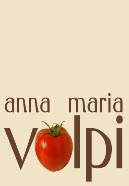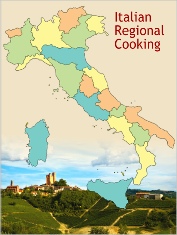







JOIN NOW
our Italian Cooking
Newsletter
our Italian Cooking
Newsletter

Publication or use of pictures, recipes, articles, or any other material form my Web site, on or off-line without written permission from the author is prohibited. If you would like to use my articles on your Web site or in your publication, contact me for details. Avoid infringing copyright law and its consequences: read the article 7 Online Copyright Myths by Judith Kallos
Read our
DISCLAIMER and
PRIVACY POLICY
before using
our site
-------------------
Linking Policy
Advertise with us
DISCLAIMER and
PRIVACY POLICY
before using
our site
-
Advertise with us
Copyright © 2003 - 2011 Anna Maria Volpi - All Rights reserved.
Anna Maria's Open Kitchen Site Map
site map
recipes
policies
about us
Some More Hot Topics You'd Like to See adv.




Anna Maria Suggests
Extra-
The Best Selection of Italian Extra-
Buy from the source Authentic Aged Traditional Balsamic Vinegar from Italy
Sicily, Apulia, Lazio, Liguria, and More...The Best Selection of Succulent Italian Olives Oil
Infused Extra-
Spice up your dishes with Infused Flavored Italian Extra-
What a revolution boiling must have been! Tougher grains, roots, and many more vegetables became edible. All the remaining nourishment and flavor could be extracted from animal bones, including the highly caloric marrow. Boiling also opened a new array of possibilities. New sensational tastes and more sophisticated preparations started appearing. Grain can make a soup thicker, oil bearing seed can enrich the flavor, and many different ingredients added to the pot change the final taste. Different combinations of meat with vegetables and herbs created the first “dishes.” Later, porridge-like preparations started appearing. The Romans acquired the practice of making these dishes, called puls, from the Etruscans. A modern dish derived from puls is polenta, still popular today in northern Italy.
During the Middle Ages, soup must have been the most common way of cooking. In times of scarcity, nothing helps utilize the few edible resources available to a hungry family better than a soup. In richer households, soups or brodetti (brodo = broth) were made. The solids (meat or vegetables), when boiled, were either picked up with sticks, knives, or bare fingers, or sometimes were served separately from the liquid (broth) that was drunk directly from the bowl. Later, during the Renaissance, soups started to be served as an introduction to meals or associated with main courses. In addition, the introduction of the spoon allowed soups to become more sophisticated and complex.
The word “suppa” (soup, soupe, sop, sopa, sopen, zuppa) originates from a Frankish word (the Franks were the most powerful of the Germanic tribes who came to inhabit the former Roman provinces of Gaul, and who eventually became the French). In the Italian language, “suppa” came to refer specifically to a dish of bread soaked in cooking broth. In fact the word “inzuppare” means to dip bread or cookies into a liquid (sop). On the other hand, in Italian, all soups are called minestra, from the Latin word minestrare (meaning to serve dishes to the table).
In Italy, there are light soups, mainly based on broth, generally served at the beginning of the dinner, or rustic chowder-like minestre that are thick and satisfying with added pasta or rice. The rice used for soups is the ever-present Carnaroli. It is Italian large grain rice that cooks evenly without becoming too soft. The pasta used in soups can be fresh pasta cut in small squares (quadrucci), larger irregular pieces (maltagliati – badly cut), or the thin capellini (angel hair). If dry pasta is used instead, the pasta could be as small as the size of a rice grain (peperini or stelline), small elbows or tubes, or even just spaghetti cut in short pieces. Rice, grains, and pasta in soups must be cooked rigorously al dente, thoroughly cooked but still firm to the bite.
Among light soups we can mention the famous Tortellini in Brodo from Bologna. It is a very sophisticated dish made of little rings of pasta filled with an aromatic mix of meats and boiled in meat broth. In Rome, we can find Stracciatella. The broth is brought to a boiling temperature and a mix of egg and grated parmigiano cheese is slowly poured into the pasta, forming small “rugs.” Italian broth is made from beef or a mix of meats (beef, beef bones, chicken, and turkey), boiled together with vegetables (carrot, celery, tomato, potato, parsley, peppercorns, and cloves), and finally degreased and filtered to remove all the residues.
During the Middle Ages, soup must have been the most common way of cooking. In times of scarcity, nothing helps utilize the few edible resources available to a hungry family better than a soup. In richer households, soups or brodetti (brodo = broth) were made. The solids (meat or vegetables), when boiled, were either picked up with sticks, knives, or bare fingers, or sometimes were served separately from the liquid (broth) that was drunk directly from the bowl. Later, during the Renaissance, soups started to be served as an introduction to meals or associated with main courses. In addition, the introduction of the spoon allowed soups to become more sophisticated and complex.
The word “suppa” (soup, soupe, sop, sopa, sopen, zuppa) originates from a Frankish word (the Franks were the most powerful of the Germanic tribes who came to inhabit the former Roman provinces of Gaul, and who eventually became the French). In the Italian language, “suppa” came to refer specifically to a dish of bread soaked in cooking broth. In fact the word “inzuppare” means to dip bread or cookies into a liquid (sop). On the other hand, in Italian, all soups are called minestra, from the Latin word minestrare (meaning to serve dishes to the table).
In Italy, there are light soups, mainly based on broth, generally served at the beginning of the dinner, or rustic chowder-
Among light soups we can mention the famous Tortellini in Brodo from Bologna. It is a very sophisticated dish made of little rings of pasta filled with an aromatic mix of meats and boiled in meat broth. In Rome, we can find Stracciatella. The broth is brought to a boiling temperature and a mix of egg and grated parmigiano cheese is slowly poured into the pasta, forming small “rugs.” Italian broth is made from beef or a mix of meats (beef, beef bones, chicken, and turkey), boiled together with vegetables (carrot, celery, tomato, potato, parsley, peppercorns, and cloves), and finally degreased and filtered to remove all the residues.

Italian Soups
Il mangiafagioli (The Beans Eater), Annibale Carracci, 1583-84, Galleria Colonna, Roma.

In Venice, we can find a very special soup called Risi e Bisi (Rice and Peas). The Venetians will tell you that this dish is neither a risotto nor a soup, since this soup-like dish is served in a creamy consistency.
Since the 1300s, this dish was traditionally served to the “Doge” (the Duke, ruler of the Serenissima, the “Most Serene” Republic of Venice) on the 25th of April during the festivities for the day dedicated to St.Mark. Rice was a very important commodity in those times. Imported from the Far East, it was at times so rare that it was sometimes sold by the grain as a spice. Rice was later planted in the plains of the Po River and became one of the staples for the people of the region.
In the mountainous regions of the Alps, Zuppa d’Orzo, a thick and satisfying barley soup, is common. The best known soup among the Italian minestre is Minestrone (meaning big soup), made with beans and a mix of all the vegetables in season. In fact, the word “minestrone” became synonym for “a mix of all things.” In Liguria, a large scoop of pesto is added into the minestrone for greater flavor. Tuscany is known for having the best Pasta e Fagioli (bean soup), also known in the United States as “pasta fazul,” from a dialectal expression of Italian immigrants. It is also in Tuscany that onion soup, carabaccia, was originated. The legend goes that Caterina De’ Medici, marrying the future King of France, took cooks with her that were to spread Tuscan dishes in France. From among these dishes, carabaccia onion soup soon became the French Soupe a l’Oignon. In Tuscany, we can also find Ribollita, a thick soup of black cabbage, and Pappa al Pomodoro, a tomato soup thickened with slices of country bread.
In the central regions of Italy, you will find many delicious soups of pasta with vegetables or legumes, like Pasta e Lenticchie (lentil soup), Pasta e Ceci (chickpea soup), Pasta e Patate (potato soup), Pasta e Broccoli (cauliflower soup), Minestra di Spinaci (spinach soup), and Riso e Indivia (rice and curly endive soup, considered healthy and refreshing). Brodo Vegetale, a light vegetarian soup of beets without pasta, and the Pancotto, bread soup, are also worth mentioning. In the mountainous regions of Abruzzo, Minestra di Farro (spelt soup) a very rustic, traditional soup of soaked spelt grains, garlic, onion, and pancetta (Italian bacon) can be found.
In Naples and the Campania region, we can find Minestra Maritata, a soup that was made famous in the United States by Italian immigrants from the area. It is a very rich soup made of meats (prosciutto, beef, sausage, and pork), vegetables (cabbage, escarole, cicory, and broccoli), and flavoring herbs (carrots, celery, onion, and parsley). The literal translation of the name is “married soup,” meaning that the ingredients (meats and vegetables) are perfectly “married” and blended together. Some translator erroneously thought it was served during Italian weddings and translated it as “Wedding Soup,” creating a lot of confusion about the meaning of this dish.
Finally, in Sicily, we find the Maccu di Fave, a simple dense soup made of dry fava beans soaked in water, boiled until tender, and then mashed to the consistency of a purée. It is eventually served lukewarm with a drizzle of Sicilian extra-virgin olive oil. This simple preparation is supposedly very ancient and goes back to Roman times, when porridge-like soups where very common. The name itself comes from the Latin word maccare, meaning “to mash.”
Zuppe di Pesce (fish soups) would require an entire chapter for themselves. Italy is a peninsula with more than 2,500 km (1,600 miles) of coastline. Every town along the coast claims a different type of fish soup with a distinctive name using fish or crustaceans from the area. These soups would include Ciuppin, Buridda, Cacciucco, Caldaro, Cassola, Brodetto, Zuppa, Sopa, Boreto, Capperata. The name varies with the region. The way it should be made and the fish that should be used is often a matter for fierce disputes.
Light soups and fish soups are served hot, but all the other Italian minestre can be enjoyed lukewarm or even cold, and can be prepared all year round. Let me share a word of advice in case you want to serve a soup lukewarm with pasta, rice, or other grains. Remember that the soup will become much thicker. In this case, the pasta should not be cooked al dente, but a little undercooked, since it will significantly soften while sitting in the pot. And remember to keep a little broth aside to be added just before serving to make the soup thinner.
Soups in Italy are as diverse as the Italian regions. We can really say, “Tell me what soup you eat, and I will tell you where you come from.”
Pietro Mascioni
© Pietro Mascioni, www.annamariavolpi.com
In the mountainous regions of the Alps, Zuppa d’Orzo, a thick and satisfying barley soup, is common. The best known soup among the Italian minestre is Minestrone (meaning big soup), made with beans and a mix of all the vegetables in season. In fact, the word “minestrone” became synonym for “a mix of all things.” In Liguria, a large scoop of pesto is added into the minestrone for greater flavor. Tuscany is known for having the best Pasta e Fagioli (bean soup), also known in the United States as “pasta fazul,” from a dialectal expression of Italian immigrants. It is also in Tuscany that onion soup, carabaccia, was originated. The legend goes that Caterina De’ Medici, marrying the future King of France, took cooks with her that were to spread Tuscan dishes in France. From among these dishes, carabaccia onion soup soon became the French Soupe a l’Oignon. In Tuscany, we can also find Ribollita, a thick soup of black cabbage, and Pappa al Pomodoro, a tomato soup thickened with slices of country bread.
In the central regions of Italy, you will find many delicious soups of pasta with vegetables or legumes, like Pasta e Lenticchie (lentil soup), Pasta e Ceci (chickpea soup), Pasta e Patate (potato soup), Pasta e Broccoli (cauliflower soup), Minestra di Spinaci (spinach soup), and Riso e Indivia (rice and curly endive soup, considered healthy and refreshing). Brodo Vegetale, a light vegetarian soup of beets without pasta, and the Pancotto, bread soup, are also worth mentioning. In the mountainous regions of Abruzzo, Minestra di Farro (spelt soup) a very rustic, traditional soup of soaked spelt grains, garlic, onion, and pancetta (Italian bacon) can be found.
In Naples and the Campania region, we can find Minestra Maritata, a soup that was made famous in the United States by Italian immigrants from the area. It is a very rich soup made of meats (prosciutto, beef, sausage, and pork), vegetables (cabbage, escarole, cicory, and broccoli), and flavoring herbs (carrots, celery, onion, and parsley). The literal translation of the name is “married soup,” meaning that the ingredients (meats and vegetables) are perfectly “married” and blended together. Some translator erroneously thought it was served during Italian weddings and translated it as “Wedding Soup,” creating a lot of confusion about the meaning of this dish.
Finally, in Sicily, we find the Maccu di Fave, a simple dense soup made of dry fava beans soaked in water, boiled until tender, and then mashed to the consistency of a purée. It is eventually served lukewarm with a drizzle of Sicilian extra-
Zuppe di Pesce (fish soups) would require an entire chapter for themselves. Italy is a peninsula with more than 2,500 km (1,600 miles) of coastline. Every town along the coast claims a different type of fish soup with a distinctive name using fish or crustaceans from the area. These soups would include Ciuppin, Buridda, Cacciucco, Caldaro, Cassola, Brodetto, Zuppa, Sopa, Boreto, Capperata. The name varies with the region. The way it should be made and the fish that should be used is often a matter for fierce disputes.
Light soups and fish soups are served hot, but all the other Italian minestre can be enjoyed lukewarm or even cold, and can be prepared all year round. Let me share a word of advice in case you want to serve a soup lukewarm with pasta, rice, or other grains. Remember that the soup will become much thicker. In this case, the pasta should not be cooked al dente, but a little undercooked, since it will significantly soften while sitting in the pot. And remember to keep a little broth aside to be added just before serving to make the soup thinner.
Soups in Italy are as diverse as the Italian regions. We can really say, “Tell me what soup you eat, and I will tell you where you come from.”
Pietro Mascioni
© Pietro Mascioni, www.annamariavolpi.com
Soup: Say the name and a steaming bowl comes to mind. However, when the warm season approaches, not many are in the mood for a sweaty session in front of a sweltering bowl. Before I start my little dissertation, I want to reassure everyone that most of Italian soups are as good boiling hot as they are lukewarm.
Now that everyone is relaxed, I will continue saying that soups are one of the oldest culinary preparations of mankind. The oldest way of cooking must be roasting. It is very easy to imagine how primitive men, as soon as they took control of fire, learned how to use the simple direct heat of the flame to cook foodstuff. Soup had a more sophisticated evolution. The origin of soup is connected with the creation of pottery and the invention of containers that could hold cooking liquid on the fire without breaking. This technique was available in Mediterranean areas around 5000 B.C.


ITALIAN SOUP RECIPES

